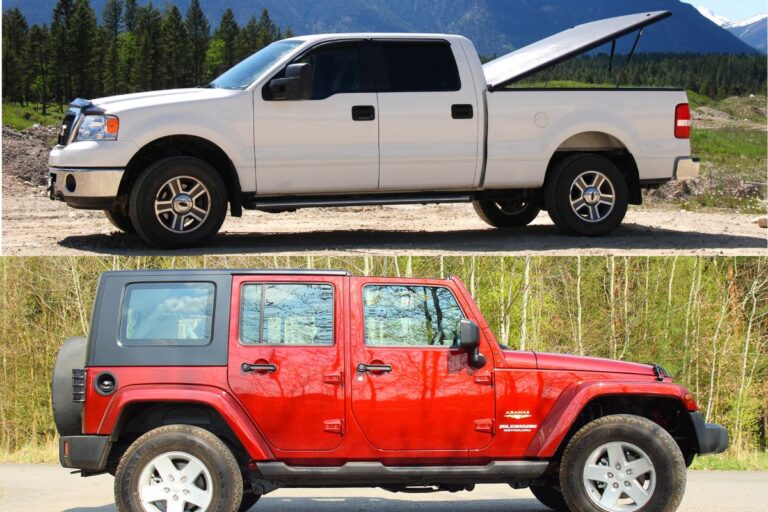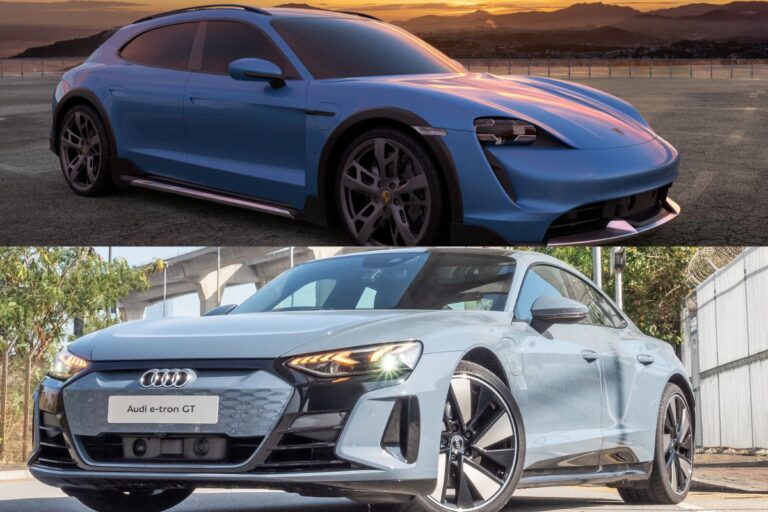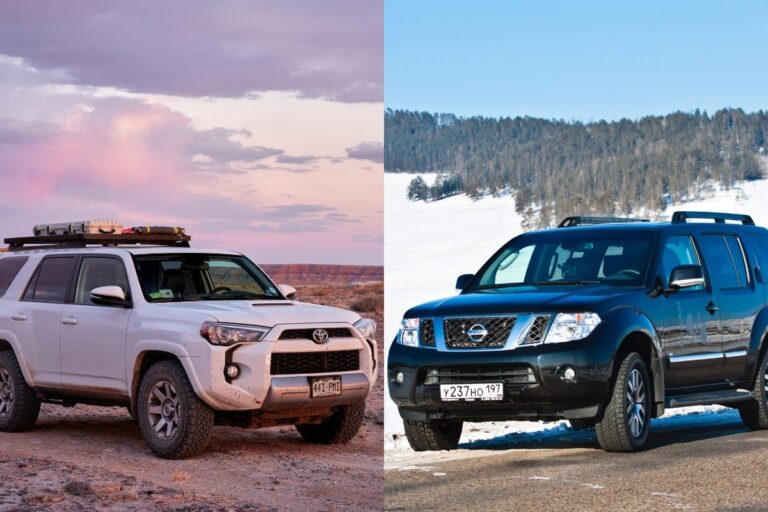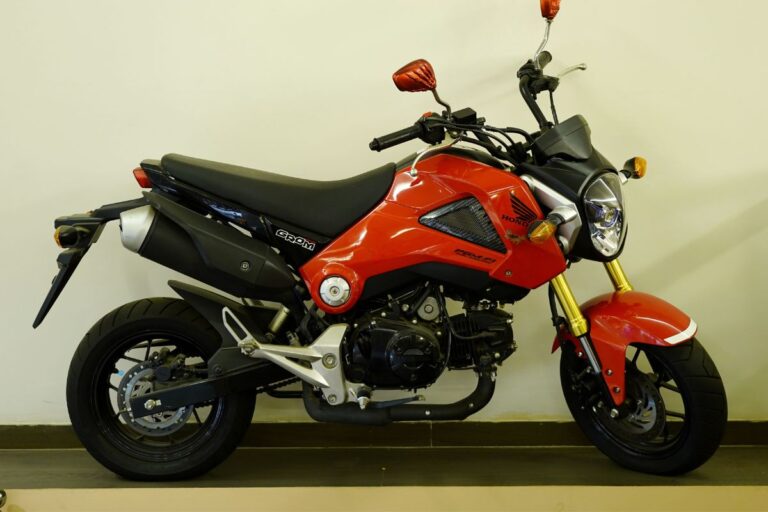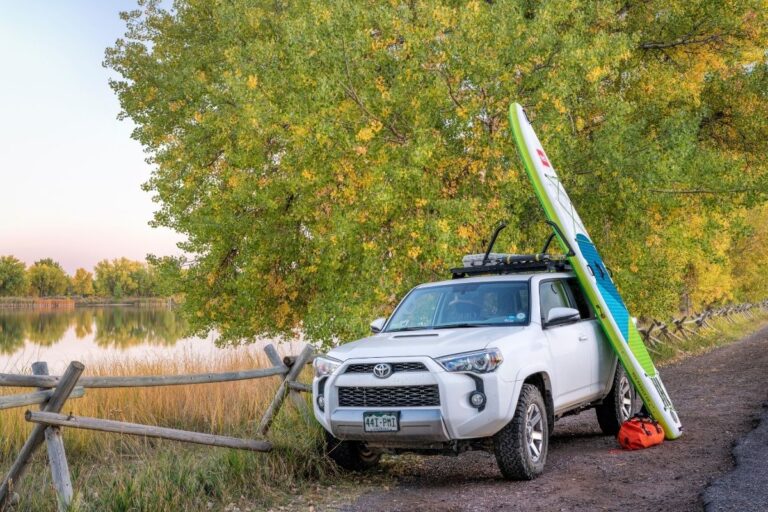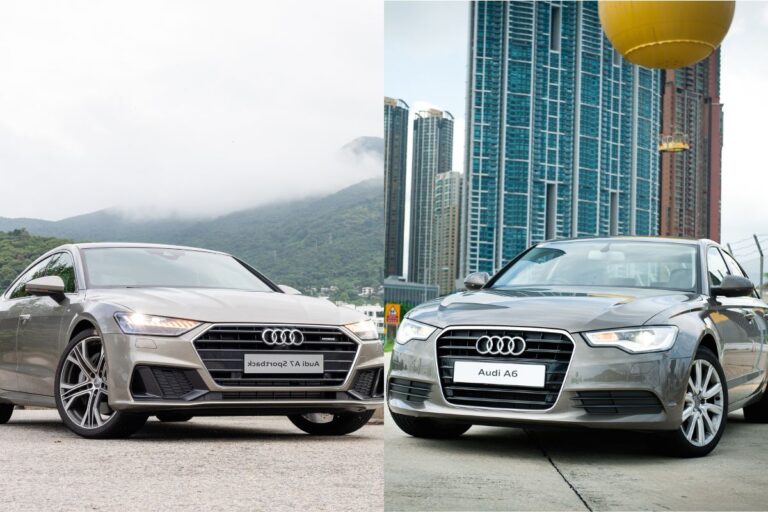
Whether you have a growing family or business, the time may have come where you need a vehicle that has more interior or cargo space. The available choices are either the SUV or the minivan.
We will compare the two vehicles so you can make the best choice based on your needs.
The top eleven factors between minivans and SUV’s are:
- cargo space,
- interior space,
- seat comfort,
- performance and handling
- safety
- price,
- towing capacity,
- fuel economy,
- off-road capability,
- technology
Each section will have either a winner or tie result, and we will use the most popular SUVs and Minivans currently available for the comparatives. Now let’s get seatbelts on and dive into the SUV VS Minivan discussion.
Minivan vs SUV – Cargo Space

One of the main reasons anyone would look at changing their sedan or hatch for either an SUV or Minivan is because they need more space. The need for more space covers both cargo and interior space and comfort, but let’s look at the cargo space first.
One of the considerations for cargo space is the amount of space available behind the third row of seats and with the third and second rows stowed away.
Average Cargo Space Behind Third Row of Seats

Looking at the top five minivans currently available – Chrysler Pacifica, Dodge Grand Caravan, Honda Odyssey, Kia Sedona, and Toyota Sienna – they each had an average of 31 cubic feet of space behind the third row of seats.
Minivans have characteristic low floors and deep cargo wells, and this gives them a significant advantage over SUVs in the cargo department.
With the third and second row of seats stowed away, each had no less than 80 cubic feet of available storage space, with the Pacifica having 88 cubic feet of storage space.
By comparison, the mid-size SUVs only have just 20 cubic feet of storage space available. To get to a similar degree of cargo space in SUVs, you’d need to go for one of the largest available, the Chevrolet Suburban.
This monster SUV has 40 cubic feet behind the third row of seats, and this is comparably larger than the minivans, and with the seats stowed, available space increases to an impressive 77 cubic feet.
Considering that an average SUV has about 33% less space and even the largest one has less available storage space with the seats stowed, it’s a clear win for the minivans in this category.
Minivan vs SUV – Interior Space

In this category, you’d need to look at how many people you would need to transport on average and whether you can stick with the default seating configuration in each style of vehicle.
Both Minivans and SUVs usually have two bucket seats up front and three passenger bench seats in the second and third rows of the interior. Some more upmarket SUVs have two captain-style chairs in the second row and the standard three-passenger bench seats in the third row.
If you have two or three kids, then having the two seats in the second row could work, and the three-passenger capacity in the third row would give you some additional space for friends or extra family members.
If you regularly move more people, losing one seat in the second row may not be a viable option, but you can elect to have the standard seating configuration without the captain’s chairs.
The five minivans listed each averaged 150 cubic feet in interior space and seating for eight people. The larger Chevrolet Suburban and the Tahoe can have a three-passenger bench in front, allowing nine people to sit.
In this category, the Minivan pips the SUV slightly lower floors to offer a bit more legroom for third-row passengers, which can be a godsend on long trips.
Comparing the average interior space, the minivan has, on average, 15 more inches of freedom than an SUV.
While most Minivans have a default seating capacity of eight people, a standard SUV has an average seating of just six people.
With approximately 5 inches more legroom space in their third row than the equivalent three-row SUV counterparts and 7 inches more space overall than the SUV, the minivan wins outright in this category.
Minivans vs SUV- Accessibility

Another area where the minivan wins is those sliding doors that make access to the vehicle and that third row much more accessible than an SUV.
The minivan is conceptualized around a people carrier and has design functionality that enhances this for its users. The other point about access is the lower step-points into the car, allowing people with mobility challenges to get in and out of a Minivan easier than an SUV.
Minvan vs SUV – Performance and Handling

SUVs may seem obvious to handle and perform better than Minivans, but this is not the case. Over the past few years, the increase in power and performance in Minivans have eroded into the performance sector once owned by SUVs.
If you consider the core structure of both types of vehicles, Minivans are built more like cars, while SUVs are built more like trucks. From a power perspective, the upper range of SUVs with three rows like the Dodge Durango and Ford Expedition push out some awe-inspiring performance numbers.
For the most part, SUVs have the edge on power with models like Tesla’s electric Model X that seats seven people can make 0-60mph in just 2,7 seconds – but then with its $100 000 price tag, that kind of power is not everyday affordable.
On the power side, the SUVs come out marginally better, but for the most part, the Minivans handle better on the road as their lower center of gravity and car-style design lends to better control and handling.
The minivan comes out ahead on the handling side, but SUVs like Mazda’s CX-9 and higher-end luxury models like the BMW X5 and Audi Q7 have superb handling.
Minivan vs SUV – Price

In this category, Minivans come out well on top! Comparing three minivans with the equivalent of three-row SUVs at the base level sees the minivans coming in an average of $6300 cheaper than their SUV counterparts.
When moving up the ladder to the more luxurious SUVs, this gap widens considerably. The top-trim models like the Toyota Sienna start at under $50k coming in at $49 415 while the comparative Ford Expedition is at least $3000 more and at the top end would come in around $80 000!
The three-row luxury SUVs would start around the $70 000 mark, making the base-trim Minivan models around $18 000 cheaper on average.
Now, if $18 000 isn’t a big deal, an SUV could be the right choice here, but anyone with a family needs to move people and cargo; $ 18 000 is a lot of fuel, tolls, and overnight stops!
In the pricing category, it’s not surprising that Minivans come out on top, but this needs to be weighed up over all the categories, as the cost is not the only consideration when choosing which option would be better.
Minivan vs SUV- Safety

The design and all-around visibility of the SUV give it a slight edge over the minivan in this category. While the minivan does have agile handling, the SUVs score marginally higher in the safety aspect.
The crash test ratings from SUVs received higher ratings than the submitted Minivans with the highest test honor – the Top Safety Pick + -from the Insurance Institute For Highway Safety being awarded to the Mazda CX9.
Seven SUVs were awarded the Top Safety Pick Accolade, and included were the KIA Telluride and the Subaru Ascent. At the same time, two Minivans achieved the same honors, namely the Honda Odyssey and Chrysler Pacifica.
While both SUVs and Minivans are available with the options of advanced safety and driver-assist features, some of the SUVs like the Toyota Sienna And Highlander come standard with lane-keeping assist, automatic braking, and adaptive cruise control.
When we looked at pricing, the pricing differences made the minivan a bit more attractive. Still, the optional safety and driving features could quickly narrow that pricing gap between the two.
Anyone transporting people, especially kids on our roads these days, should be considering the peace of mind brought with the extra safety and driver-assist features that both vehicles offer.
In this category, the SUV comes out marginally ahead of the minivan.
Minivan vs SUV- The Scoreboard So Far
Having come halfway through this discussion, it seems that Minivans have the edge over their SUV counterparts with three clear category wins in cargo and interior space and price and a tie in the handling side, with SUVs only winning one in the safety category.
With a 3-1 advantage and one tied category, it would appear that when it comes to transporting people, Minivans do indeed look as though they are leading well into the second half.
But we have not covered all the aspects involved here, so let’s prepare for the second half and get into the other comparisons.
Minivan vs SUV – Towing Capacity
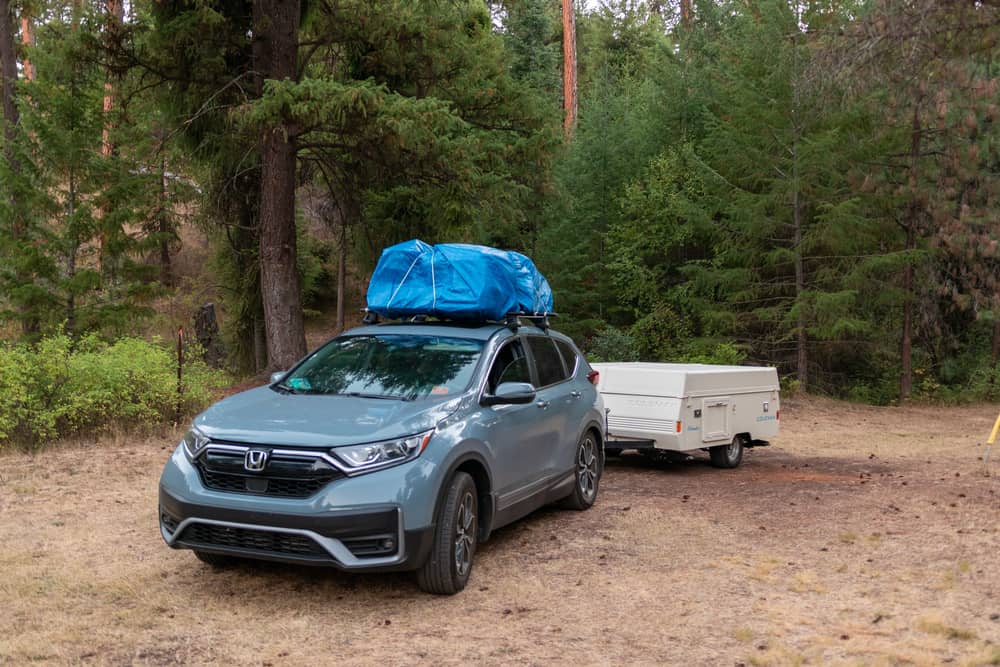
SUVs are going to start this round strongly by taking the honors by a mile in this category.
The SUVs overall have more brawn when it comes to power and towing. Most Minivans only have an all-wheel drive as an optional upgrade, which can be a costly option.
The maximum towing capacity of any minivan is governed at 3600 pounds and would only be suitable for light towing at best. Anything heavier than that, the minivan is woefully outclassed.
Even a mid-range SUV like the Enclave from Buick can heft a sturdy 5000 load, and some of the bigger SUVs can tow more than the best compact pick-ups. For example, the Ford Expedition has an impressive rated towing capacity of 9300 pounds.
The Chev Suburban can tow around 8300 pounds without breaking a sweat, and those numbers relegate the minivan to pre-school level when it comes to power and towing capacity.
Some SUVs have technology and features that allow them to tow anyone or anything like a pro regardless of towing experience!
Because SUVs are based more on truck design than car design, towing is one of those categories where there is no real competition, so SUVs win this one hand down.
Minivan vs SUV – In-Cabin Technology

When it comes to the technology found in the cabin, the rule of thumb is clear. The higher up with the trim you go, the more amenities you get!
One aspect to consider is that the technology in Minivans is more orientated toward family and children. At the same time, the tech in an SUV is focused more on driving assistance like visibility and other camera and sensor assistance.
The systems found in SUVs and Minivans are the ones you’d expect, like back seat entertainment systems for playing movies and games to keep kids and other passengers occupied while driving.
Apple Car Play and Android Auto are typical, and surround-view cameras abound, as do rear USB charging ports to keep those devices powered up on the trip. The Honda Odyssey even has a vacuum included as they know the mess that can accumulate on long trips.
The SUV’s path diverges with driver-assist technology like automatic rear braking, preventing drivers from colliding with objects. SUVs like the VW Atlas and Nissan’s Armada have this, and while this type of technology is standard with most SUVs, only the Pacifica by Chrysler has this feature.
In context, SUVs are more truck-like and aimed at the driving performance and safety aspect with some consideration for the in-cabin entertainment.
Minivans would be weighted toward the in-flight distractions so that the driver and front-seat passenger can focus on driving and remain largely undisturbed by people in the back.
There is no clear winner in this category as each can provide the required level of technology and additional features for a price – so here, the honors are even.
Minivan vs SUV – Off-Road Handling

In this category, there is only one clear winner, and that is the SUV. Most SUVs have four-wheel and all-wheel drive as standard, and as such, the minivan is not really in this category.
SUVs have higher ground clearance, allowing for far better handling on rough terrain than any Minivan could deliver. Let’s face it; the average minivan is not designed or equipped to go off-road, especially with eight people and luggage stacked in the back.
The Toyota Sienna is one of the few Minivans with all-wheel drive. Even so, it’s improbable that they would find themselves purposefully taking on rough off-road conditions.
This is also because the suspension systems on Minivans are not designed to take that kind of punishment. Any travel off tar roads would be excruciatingly slow and arduous to avoid any damage to the vehicle.
Having said this, taking your smaller SUV or Minivan on properly harsh roads is not advised as even the smaller SUVs would probably not be able to withstand that kind of treatment, and the minivan most definitely not.
This is a case of horse for courses. While an SUV would be better suited, if you do the driving that takes you through Paris-Dakar type conditions, then the bigger SUVs like the Toyota Landcruiser or the Land Rover Range Rover would be better suited – but with a price tag of around $86 000, it’s an expensive excursion.
For the off-road category, the SUV wins.
Minivan vs SUV – Stormy And Inclement Weather

A sub-category of off-road deals with harsh weather conditions like storms, snow, and other poor natural conditions that can adversely affect driving.
The built-in safety features on an SUV make these vehicles more adapted to handling adverse weather, but Minivans are also capable to a point. The four-wheel or all-wheel drive makes driving through lousy weather easier for the SUV.
The car-type minivan would struggle with severe rain and wind as the minivan’s design is less aerodynamic than that of an SUV, especially with the flat sliding door side in play.
When it comes to off-road and adverse weather handling, the SUV wins both of those categories.
Minivan vs SUV – Fuel Economy

Aside from the price and safety, fuel economy is one of the most significant factors to consider when deciding between the two vehicles.
Now, before we get into this, it’s worthwhile remembering that ANY vehicle that would be carrying six to eight people is not going to be on the low end of exceptional fuel economy.
Still, the cost of fuel in terms of overall suitability has to be considered, and here the Minivans walk out on top. A V6 engine powers every minivan available in the US, and as such, the mileage numbers will be high.
The figures below would be valid for average loads and speeds, and overloaded vehicles or consistent high-speed driving would lower these significantly.
Realistically, most minivans would deliver an economy of between 24mpg and 30mpg on the open highway and around 19mpg in city driving. These numbers are nothing to write home about, but they are better than the average V8-powered SUV.
Rear-wheel drive SUVs offer better mileage than all-wheel options, with fuel economy of around 23mpg on the highway vs. 21 mpg, respectively. Some SUVs like the Lexus GX only deliver a paltry 18mpg on the road.
At the outset, the minivan would appear to win the fuel economy contest.
Minivan vs SUV – Fuel Economy in Hybrid Models

Here is where things get a bit more interesting as the development of hybrid engines for both types of vehicles has substantially improved the fuel economy all around.
With the new 2021 and 2022 models of minivans like the Chrysler Pacifica and Toyota Sienna available with 2.5 L hybrid engines (Sienna) and 3.6l Plugin Hybrid (Pacifica), thee fuel economy is far better.
The Sienna is now delivering an impressive 36mpg for both city and highway, and the Pacifica offers 29mpg for city and 30mpg on the road.
While that is a vast improvement, consider the SUV performance in fuel economy of the Ford Escape Hybrid at a staggering 41mpg and Toyota’s Rav 4 Hybrid at 40mpg!
While these SUVs are the smaller ones, the effect of hybrid engine technology is blurring the lines of a once-clear advantage minivan had over SUVs in fuel economy.
Minivan vs. SUV – Fuel Economy in Electric Models

Even more impressive are the numbers from the electric models, which make the numbers above look obsolete.
The Chrysler Pacifica Hybrid provides an impressive 82 mpge, but that pales in comparison to the performance of the electric SUVs.
IN the SUV class, the top three SUVs for fuel economy in electric are:
- The Tesla Model Y at 111-125 mpge
- Hyundai Kona Electric – 120 mpge
- Ford Mustang Mach E – 90-101 mpge
Now, while those numbers need to be weighed against the price as the electric SUVs and Minivans will be significantly more expensive than the hybrid or standard engine options, you need to evaluate this over the vehicle’s lifetime.
You may find that while the upfront investment is a lot higher, the fuel savings over an 8-10 year ownership period may well be worth it, and many electric vehicles carry tax incentives as well.
We’d have to call it even overall in the fuel economy department, but with standard engines, the minivan would edge the SUV.
Minivan vs SUV – The Scoreboard
At the halfway mark, it was the minivan leading 3-1, but at the end, that score has evened out with the SUV winning the towing, off-road, and inclement weather categories and a tie in the technology sector.
We could say that the minivan won the fuel economy sector, but that would be a tie, taking all things into account.
So, in the end, the scores come out even.
Conclusion
The battle between the minivan and the SUV will continue, but the reality is that each has a specific purpose and design, and they must be viewed as such for you to make the best choice for your family and driving requirements.
The minivan would be a better choice for larger groups of people and luggage, while for smaller groups of people looking for a little off-road adventure, the SUV would be better.
What is clear, though, is that while the design of these two vehicles is distinct, the factors that used to distinguish them are no longer as well defined as they used to and it wouldn’t surprise anyone to find a SU-Van type vehicle down the road that brings the best of both worlds!
Resources:
Car and Driver: Best Vehicle for Family
US News: SUVs vs. Minivans
MotorTrend: Best Gas Mileage SUVs
True Car: Best Minivans by Gas Mileage

